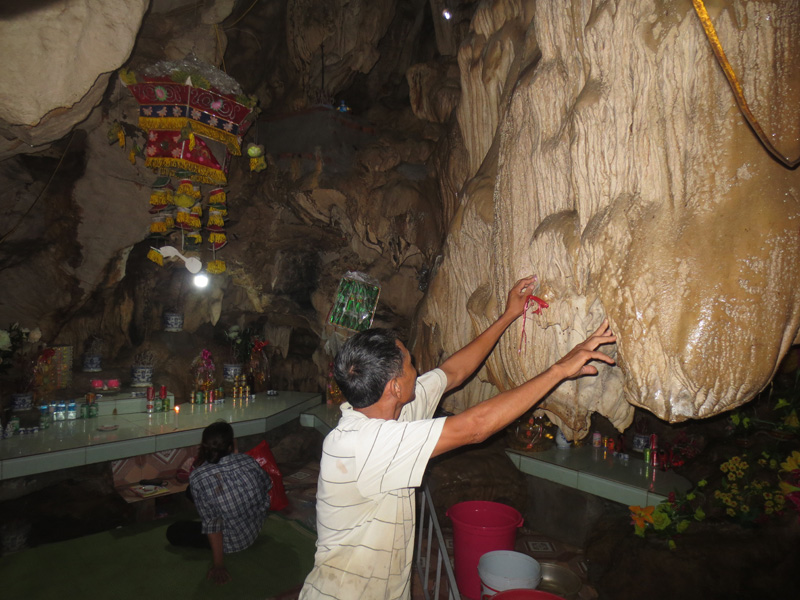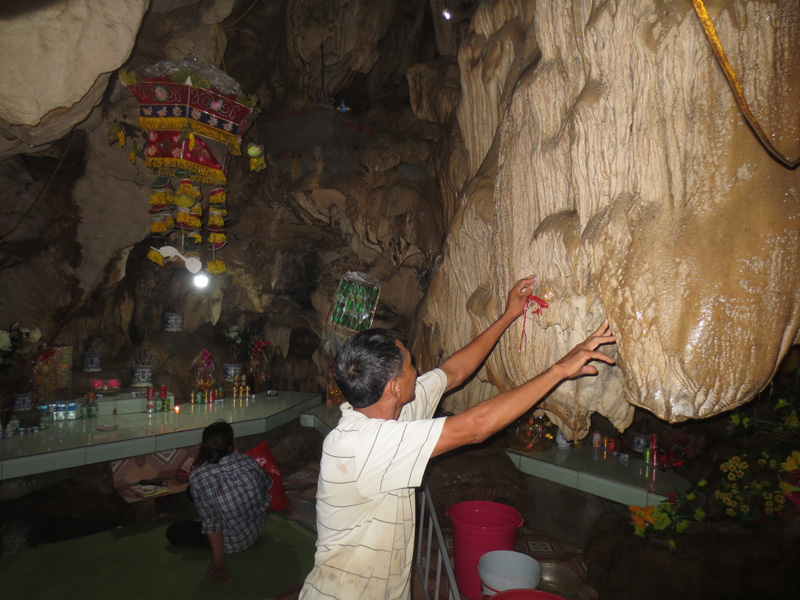
(HBO) - Ngoc Luong commune (Yen Thuy) is not only famous for smooth and flexible Cheo’s rhythm but also a lot of beauty sceneries with the mysterious cave system. Hum Cave is a cave containing many beautiful stalactites created by nature for millions of years, along with the system of worshipping the sacred Buddha in the cave to create the attraction for those who love discovering the natural mystery.

People exploiting the mysterious beauty of Hum cave in Ngoc Luong commune,
Yen Thuy district.
Hum cave belongs to the Nghia
mountain complex in Nghia village, Ngoc Luong commune, Yen Thuy district. The
cave is located at the altitude of about
20 meters above the
field. The cave is known as a majestic hall for Nghia pagoda to lean on. The
cave is created with two interconnected entrances, one in the northeast and one
in the northwest.
From the northeast entrance, you
can see a large green field. Hum cave has the total length of about
100 meters, including
the side niche. The entrance has the width of
1 meter, the height of
0,8 meter and is divided
into 2 floors; you have to spleen through the first floor to the second one,
where can then be spleened through a small niche of
0,6 meter in diameter to
the first arc grotto. This is the stopover for the tourists to discover the
beauty of the cave before exploring the deep interior. When reaching the room,
the visitors will feel fresh and cool. There are a lot of stalactites on the
two sides which are dripping to welcome guests.
Going deep into the cave, tourists can admire
the real world as well as many virtual shapes. Looking at the right side of the
cave wall, we can be surprised at many stalactites with vivid and funny images
like thousands of shapes and appearances of flowers, leaves, trees, birds and
wild animals. All seems to move around. The stone is no longer idle but turns
into the animals with a sense of mind and soul according to the imagination of
the visitors. On the cave arc, the stalactites are dripping like the arrows for
hunting wild animals of the ancient Muong ethnics.The droplets at the top of
the stalactites are shining like glittering stars to erase the dark space in
the cave when the light is shining at them.
Large and small series of
stalactites are like in a natural drawing with brilliant colors and have many
different shapes depending on the people’s imagination. This makes us feel like
walking in a lively world together with hidden creatures turning to stones in
millions of years.
Ms. Nguyen Thi Thao, the guardian
of Hum cave said: At the beginning of spring or on the lunar first and
fifteenth day, Ngoc Luong people, especially the guardians, often visit the pagoda
in Hum cave to incense and pray for peace. The old Hum cave had many
stalactites shaped like Buddha images, therefore, the authorities and people in
Ngoc Luong commune set up Buddhist churches to show their worship of the sacred
cave. The sacred Buddhist world in Hum cave is being worshipped by people with
the desire for health, peace and abundant crops.
Mr. Bui Ngoc Ban, Deputy Chairman of
Ngoc Luong Commune People’s Committee said: At present, Hum cave is well known
by many visitors, especially the young who like experiencing and exploiting new
places. On the vacation days like 30/04, 1/5 and 2/9, a lot of the young groups
go to the cave to exploit the mysterious beauty of the cave. Therefore, to
promote the historic values of million years of Hum cave and meet the spiritual
demand and exploring need of the people and tourists, Ngoc Luong Commune
People’s Committee has set up a Management Board of Nghia Moutain Historical
Complex. This board will focus on planning, maintaining the signposts, parking
areas to ensure the order and security here.
A diverse chain of eco-tourism and resort destinations concentrated in Hoa Binh city and the districts of Tan Lac, Da Bac, and Luong Son… Along with the launch of several key high-quality resort tourism projects, these developments have reshaped the landscape and enhanced the appeal of Hoa Binh as a travel destination.
Boasting diverse terrain, a mild climate, and rich natural resources, Cao Phong district is increasingly asserting its place on Vietnam’s tourism map, attracting both domestic and foreign visitors. The district is renowned for its stunning landscapes, majestic mountains, a crystal-clear hydropower lake, and the unique cultural identity of local ethnic groups.
With its pristine landscapes, unique cultural heritage of Muong ethnic minority, and an expanding range of visitor experiences, Tan Lac district of Hoa Binh has fast become a captivating destination for both domestic and international tourists.
Until now, Sung village in Cao Son commune, Da Bac district remains the only Dao ethnic community in Hoa Binh province to develop a community-based tourism model. Beyond its untouched natural landscapes, cultural identity serves as the cornerstone attraction for visitors.
Alongside the diverse cultural identities of the Kinh, Muong, Tay, Thai, Dao, and Mong ethnic people, Hoa Binh province is also renowned as the "capital" of the northwestern Vietnamese cuisine, offering unique and distinctive dishes. At festivals, during Lunar New Year (Tet), or on significant family or community occasions, special dishes are prepared, leaving a lasting impression on visitors.
A Phong Linh (Yellow Tabebuia) flower garden in Thang village, Thach Yen commune, Cao Phong district is currently in full bloom, drawing a large number of visitors.



